Holocaust remembrance in Dnipro
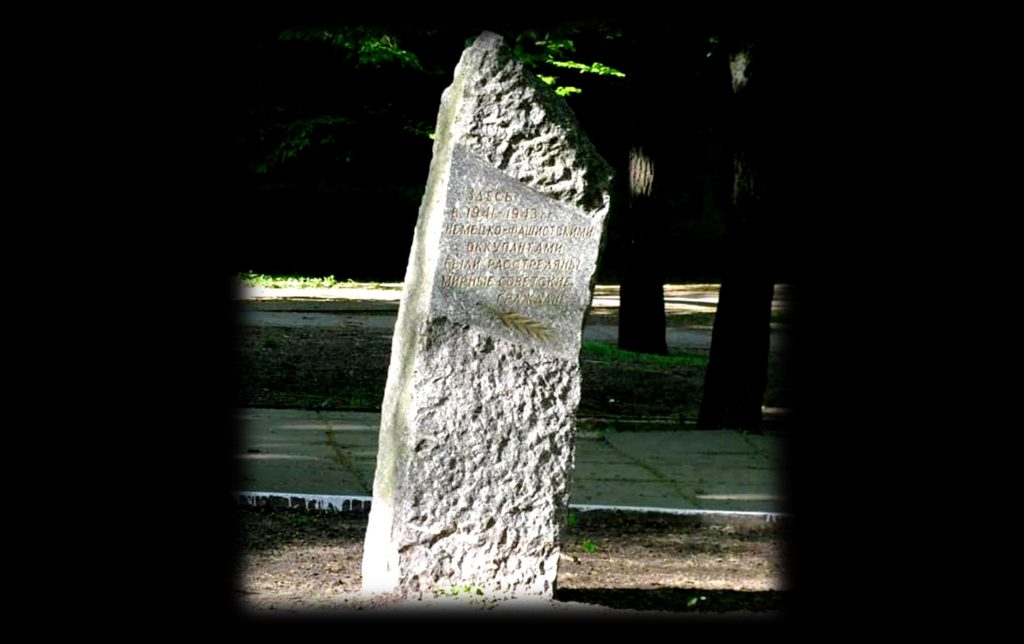
This article examines the key transformations that have taken place at Holocaust sites in the city of Dnipro (formerly known as Dnipropetrovsk) from the end of the Nazi occupation until the present day. Attention is focused on the mechanisms and features of including the commemoration of Holocaust victims in the urban space. The author examines the main initiators and supporters of the commemoration of the Holocaust in order to assess how effectively the history of the murder of the Jews is represented in the urban space of Dnipro and whether this representation corresponds to its current images. The article recounts the events that took place at three main Holocaust sites in Dnipro: near the Botanical Garden (Chervonoarmiiska balka); the Jewish cemetery (Pysarzhevsky Park); and the village of Verkhnie (the intersection of Yangel and Enerhetychna streets).
After the collapse of the USSR, and especially in recent decades, an active search has been taking place for a new identity for this city on the Dnipro River. This is accompanied by the sifting of many different images and topics relating to the history of the city, its earlier accomplishments, and ambitions.
During the Soviet period (1959–1987) the city held the status of a conditionally closed city [1] because of the secret production of rocket artillery at the Pivdenny Machine-Building Plant. As a result, the special relations with the central government intensified ideological control, and a better supply of food and other privileges accorded a sense of importance to the city, which predetermined the emergence in non-official discourse of such descriptions as “the city of stagnation” [2] and “the forge of cadres,” as well as of a joke about the “Dnipropetrovsk period of the history of Rus′,” etc. In the post-Soviet reality, according to the researchers Andrii and Tetiana Portnov, “in the fundamentally new political and ideological situation, the local function of the Brezhnev myth has preserved its importance.” [3]
The current municipal authorities, cognizant of these demands, are seeking to emphasize and, possibly, to revive the once-prevalent concept of a so-called metropolitan area by advancing its own programs and projects related to the image of the city as an industrial, business, scientific and technical, aerospace, and even cultural capital.
Another distinctive feature of Dnipro’s image to a certain extent is its revived and developed Jewish life, the result of the work undertaken by the city’s powerful Jewish religious and cultural community. Its leaders have succeeded in attracting investments and donations from a number of social assistance agencies, build a number of social assistance institutions, restore the synagogue, and, in 2012, to create the Menorah, one of the largest Jewish civic centers in the world, a building today that is an integral feature of the city’s urban landscape and one of its visual symbols.
The first Holocaust museum in Ukraine [4] opened that same year. Its collection recreates the stories and destiny of the Jews not only in this region but throughout Ukraine, thus underscoring the all-Ukrainian scale and significance of the Holocaust.
The flourishing Jewish community has become an integral element of Dnipro’s new identity. The Holocaust, as one of the essential aspects of Jewish history in general and of this city in particular, is also recreated in the urban space.
The goal of this research article is to demonstrate the key memorial transformations that have taken place at Holocaust sites in Dnipro (Dnipropetrovsk) from the end of the occupation to the present day; to analyze the extent to which these territories became sites of memory of the Holocaust; to describe the mechanisms and features of embedding this memory in the city’s symbolic space; to identify the main initiator and consumer/target of Holocaust memorialization; and to assess how effectively the memory of the destruction of the Jews is recreated in the urban space and whether it corresponds to its contemporary image.
The historiography of the question
The Holocaust in Dnipropetrovsk — like the question of its memory, its reception in social thought, and representation in the memorial space — is reflected quite modestly in contemporary historiography. There is an extraordinarily small number of works that one can refer to in order to identify on a city map the main sites where the Holocaust took place and to establish a chronology of events. To a certain extent, the Nazis’ anti-Jewish policy in occupied Dnipropetrovsk is reflected in the works of a few regional or amateur historians, as well as professional researchers such as O. Kruglov [5], Karel Berkhoff [6], А. Umansky, I. Shchupak [7], and others. However, the most complete regional scholarly research to date on the genocide of the Jews of Dnipropetrovsk is a monograph written by a group of authors from the Tkuma Ukrainian Institute for Holocaust Research. [8] They examined a wide range of sources, including archival materials held at the State Archive of Dnipropetrovsk Oblast (DADO); a significant number of narrative sources, particularly diaries kept by city residents, who described everyday life under the occupation; and oral histories — memoirs of eyewitnesses and survivor testimonies. Relying on a large corpus of documents and published studies, the authors present the history of the Holocaust in the context of the prewar life of the city’s Jewish population, the course of military operations, and the occupying regime. A separate chapter is devoted to Jewish resistance and accounts of rescues.
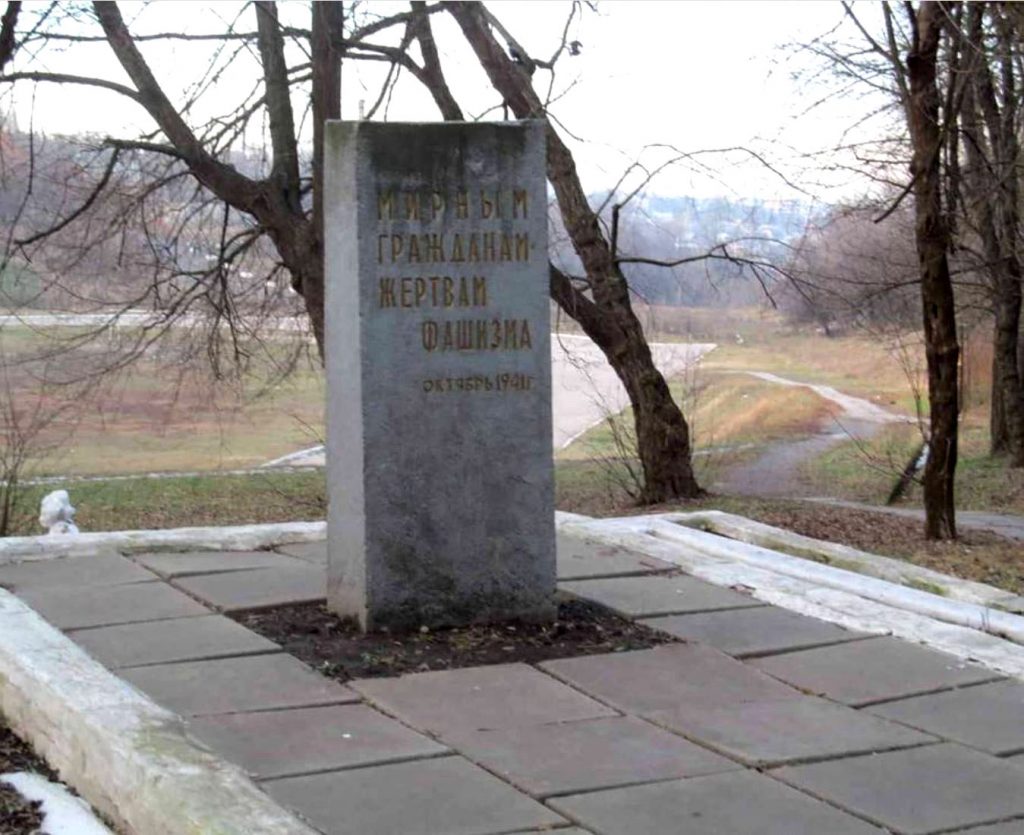
The memory of the Holocaust in Ukraine is examined in a monograph by Georgii Kasyanov. [9]. The subchapter “Genocides by the Wayside” discusses the instrumentalization of the tragedy of the Jews by the Ukrainian political elite in the conditions of the reigning, exclusive model of historical memory on which the Ukrainian national project is based today. The recently published collective monograph Politics and Memory: Dnipro, Zaporizhia, Odesa, Kharkiv: From the 1990s to the Present Day [10] offers a detailed analysis of the Holocaust museum exhibition in Dnipro, noting that in this city and other regional centers the key role in memorializing the Holocaust is played by non-state actors. [11] As for the reception of the Holocaust in the postwar Soviet and post-Soviet periods, it is worth mentioning an article by Andrii Portnov. [12] He focuses on the dual memorialization of the Holocaust, citing the example of Dnipropetrovsk, and on the differing identities of those who were killed, which are recreated in commemorative markers. However, his text offers a statement of the problem and an articulation of the phenomenon, rather than a thorough analysis.
Such an analysis would require, first and foremost, an understanding of what took place in those areas of occupied Dnipropetrovsk where monuments are standing today. This would help formulate a complex description of the main sites associated with the murder of Jews and the events that occurred there.
Where the Holocaust took place
On 13 October 1941, the Jewish population of Dnipropetrovsk was assembled on the square behind the Lux department store (today: the Central department store), 52 Karl Marx Prospect. [13] The people were searched, and their valuables were confiscated. They were then grouped in columns and escorted under convoy to the exit from the city in the direction of the Zaporizhia Highway. [14] In the vicinity of the old Jewish cemetery near what was then called Darwin Street [15], the Jews were driven into a ravine that was part of Chervonopovstanska balka [Ukr. balka: a gently-sloping ravine — Trans.] on the grounds of the Botanical Garden. [16] It was on this very spot that the first mass shooting in Dnipropetrovsk, lasting two days, took place. According to a German report, on 13 and 14 October a team commanded by an SS-Supreme Group Leader, together with the police, killed “approximately 10,000” Jews. [17] Over the next month, nearly a thousand more Jews were shot there. [18]
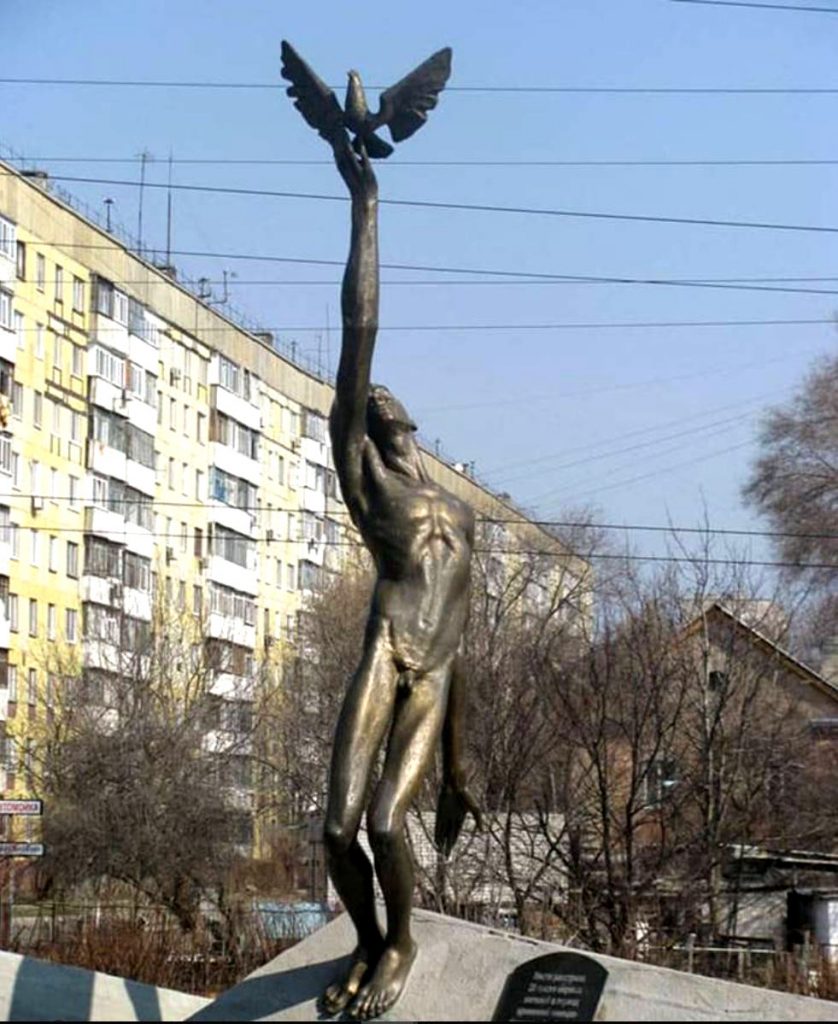
Henceforth, Jews were killed together with other population categories, mostly communists and partisans. No more sites where Jews were killed exclusively have been recorded. In late 1941 shootings took place in an anti-tank trench near the Jewish cemetery (today: the grounds of Pysarzhevsky Park). According to the testimony of one eyewitness, up to a hundred people were brought there every day, among them a significant number of Jews. [19]
Another location where people were shot, including Jews, was an anti-tank trench near the village of Verkhnie (today: the corner of Yangel and Enerhetychna streets). This took place from December 1941 to the end of the occupation. People were brought on trucks because at the time this place was located four kilometers from the city. [20] During the Nazi occupation of Dnipropetrovsk between 17,000 and 21,000 Jews were shot. [21]
Postwar Soviet transformations
Immediately after the German troop withdrawal in 1943, the exhumations of victims’ bodies took place at some mass shooting sites, first and foremost on the grounds of the Botanical Garden. However, in other places no one bothered about the remains, the repercussions of this decision were subsequently felt repeatedly. [22]
In the following decades, the landscape of these areas actively changed as the city was rapidly built up and developed. In keeping with the widespread practice of the Soviet period, former cemeteries were transformed into parks and recreation areas. The Jewish cemetery, near which, as mentioned earlier, Jews and other persecuted categories of the population were shot, was no exception.
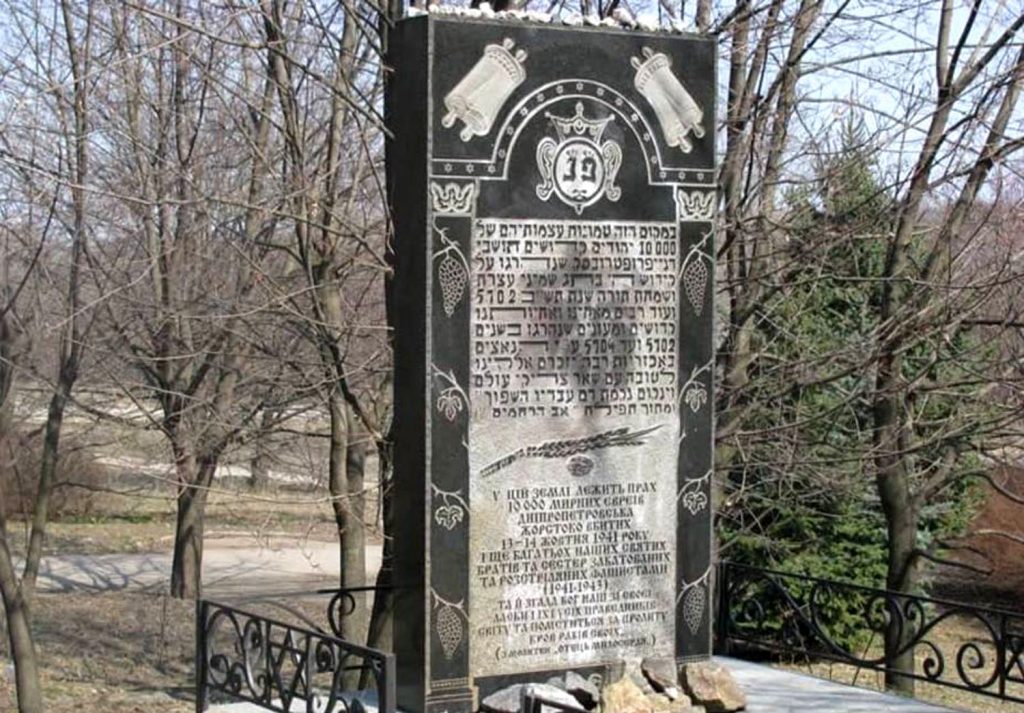
The cemetery was dismantled in the early 1960s, and a park named after the famous Soviet [Ukrainian] chemist Lev Volodymyrovych Pysarzhevsky was built in its place. He was buried in this Jewish cemetery, so his grave was preserved, and a monument and a commemorative plaque were erected. Throughout the 1960s and 1970s residential high-rises and shops were built around the park. In another section of the park, near the pedestrian alley, a short stele was erected, featuring a typical Russian-language inscription: “Here in 1941–1943 Soviet civilians were shot by the German-fascist occupiers.” During the Soviet period, no other commemorative actions were undertaken in this location.
The killing site near the Botanical Garden (still in operation today) also underwent significant changes when the surrounding grounds were considerably built up. The first building of Dnipropetrovsk State University, which in 1954 was named in honor of the 300th anniversary of the reunification of Ukraine and Russia, was constructed in the 1970s, as were other buildings: the library, a sports complex, and a stadium. A park named in honor of [the Soviet cosmonaut — Trans.] Yuri Gagarin was created, and the first stationary monument was erected there in 1974. Its inscription was even more euphemistic: “To civilian victims of fascism, October 1941.”
The phrasing of inscriptions on Soviet commemorative markers was typical and maximally unified, as though monuments, as well as any other socially significant facilities (grocery stores, schools, laundromats), were not supposed to reflect events that had happened in a precise spot but were units of a certain memorial infrastructure, which were wholly stripped of unique features — all the way to utter facelessness. The only difference was the degree of abstractness. If you compare the two above-mentioned inscriptions that appear on the monuments which were installed at roughly the same time, you will notice that the text on the monument standing in Pysarzhevsky Park has at least some connection to the place (the word “here”), dates (1941–1943”), and actions (“were shot”), even though the victims were identified as “Soviet citizens.” The inscription on the stele in Gagarin Park mentions only a partial date (October 1941). With what can the selection of such a text be connected? What makes this place special, compared to others, is that only Jews were shot here, and the mass killings were on the largest scale. The purpose of this semi-silence was formally to immortalize the memory of the victims, but in reality — to conceal and blur their fate. Everything about the look of the monument indicates that it was intended to be invisible: the color (gray); the design (a rectangle without any additional details); location (on one side of the pedestrian alley leading from Gagarin Prospect to various university buildings); and, of course, the text, which was so laconic and unspecific that a clear slab would have been more eloquent.
No official events to honor the memory of the murdered people were held at the killing site until 1989. [23] However, on the initiative of a few members of the city’s Jewish community, secret (unofficial) commemorative practices (the whispering of a Jewish prayer) took place there. They were organized on the anniversaries of the shootings, either on 13 or 14 October. [24] Owing to the small number of people taking part in these actions, the local authorities did not obstruct them. However, they clearly saw this place as a potentially dangerous Jewish symbol, similar to Babyn Yar.
Thus, the Soviet policy of memory and the embellishment of symbolic space simultaneously entailed both the immortalization and the silencing of the Holocaust, the dilution of the memory of the real 11,000 Dnipropetrovsk residents of Jewish background within the multimillion mass of “victims of fascism.”
As for the place where shootings took place near the village of Verkhnie, this area during the postwar decades was vigorously built up, especially on the site of the anti-tank trench, where a multi-storey residential building was constructed at 39 Yangel Street. A sports stadium was built nearby, along with other social infrastructure typical of a residential neighborhood in a Soviet city. The monument that was installed there in the 1980s differs fundamentally from the two earlier ones, above all in terms of style. It is a bronze sculpture depicting a man holding a bird in his right hand, raised upward.
The pedestal of the sculpture is formed of several pyramids resembling mountain peaks among which is laid out a path with stairs. The inscription on the memorial plaque is a typical example of Soviet phraseology: “The place where 20,000 civilians were shot during the period of the temporary German-fascist occupation. September 1943” — also written in Russian. There is an indicator of the action and a connection to the location; the number of victims is also indicated — 20,000 — but their identity remains unchanged: “civilians.” The date revealed in the inscription begs the question: From the factual description we know that the shootings at this site took place for nearly two years, and various population groups were killed there, not just Jews. If we suppose that the goal of the authors of the inscription was to memorialize only those people who were shot in September 1943, then this monument cannot have any connection to Jews because, according to German registration documents, as of 7 May 1943, not a single Jews was registered in the city. [25]
Post-Soviet transformations
According to Pierre Nora, after the collapse of the Soviet Union, “there came the moment of acquiring memory” in Eastern Europe, [26] which was accompanied by a detabooization, the democratization of history, and ideological decolonization. All these processes anticipated the emergence, as a result of “the emancipation of peoples, ethnicities, groups, [27] of the memory of minorities, for whom “reclaiming their past is an indispensable condition of forming one’s identity.” [28] It is worthwhile examining how these processes were reflected in memorial practices at Holocaust sites in post-Soviet Dnipropetrovsk.
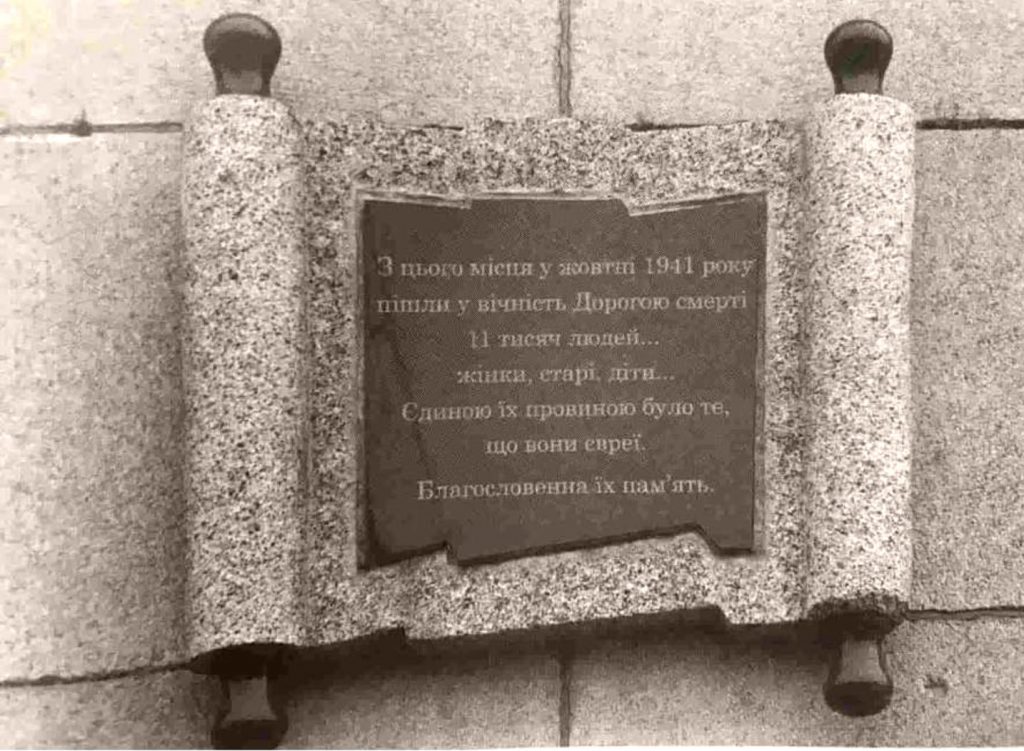
In 2001, ahead of the 60th anniversary of the shootings in Gagarin Park, the Jewish community of Dnipropetrovsk erected another memorial marker several hundred meters away from the Soviet monument dedicated to civilians. Unlike the Soviet monument, this one is much more richly decorated, the inscription is longer, and it mentions the ethnic affiliation of the murdered people. The commemorative marker was designed by Arkadii Shmist, a Dnipropetrovsk-based architect and civic activist, who had taken part in the secret actions to commemorate the dead which took place here during the Soviet era. The monument is a rather tall slab of black granite, embellished with drawings and Jewish religious symbols. In the center is a bilingual Hebrew and Ukrainian text. The small square around the monument is laid out with pavers and surrounded by a low, wrought-iron fence that is also decorated with Jewish symbols (Star of David). In keeping with Jewish religious tradition, stones instead of flowers lie near the pedestal. Inscribed on the monument are a quotation from the prayer “Merciful Father” and the following text: “In this earth lie the remains of 10,000 Jewish civilians of Dnipropetrovsk, who were brutally killed on 13–14 October 1941, and many of our holy brothers and sisters who were tortured and shot by the fascists (1941–1943).” In other words, the memory, first and foremost, of the victims of the first and largest mass shootings is honored (underscoring the date of 13–14 October), as well as of other people who were shot there during the years of the German occupation.
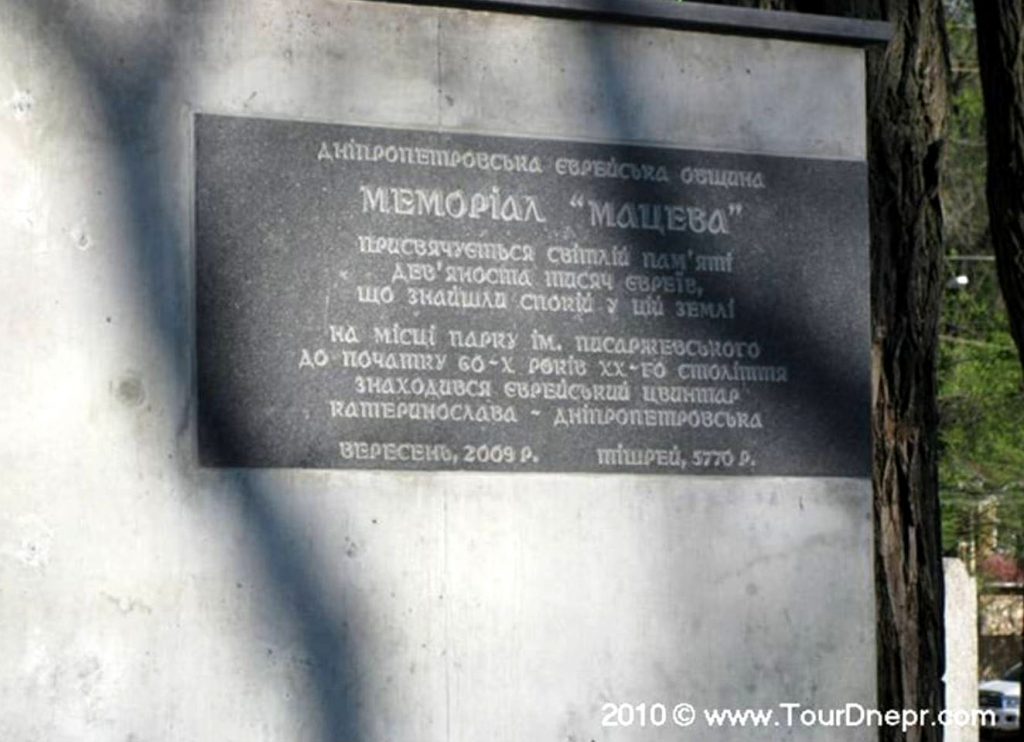
In comparing the last two examples of the memorialization of the Holocaust, one cannot fail to notice that in a strange way both of them, neither of which is truly in conflict with each other [29], do not fit either the urban space or the general historical narrative of the city. They do not communicate with anyone; the first one, because of its facelessness, and the second one, because of its openly Jewish identity. These two memorial practices embody entirely different world perceptions: Jewish traditional (religious) and Soviet internationalist. From the standpoint of the representation of worldview positions, particularly the idea of how crucial it is to honor the memory of the victims, both monuments are completely representative. In the context of recreating objective reality, neither of them lays claim to doing this. After all, in order to do this, it is worth reflecting on who the Jews who perished there really were. What types of identity were characteristic of them? What united them, apart from ethnic origin? To what degree were nationality and religion important to them? Of course, in this case, there cannot be unambiguous, simple, or universal answers for everyone. However, all these questions require reflection if the goal of erecting a commemorative marker is not only to satisfy the needs of the initiators, but also to present the past in a fitting way, to encourage it to speak not only to city residents of Jewish background but also to other residents of the city.
Some progress in this direction was achieved in 2010, when the Jewish community organized the installation of a memorial plaque on the wall of the Central department store (today: 52 Prospekt Yavornytskoho), the location where the Jews were assembled on 13 October 1941. It bears the following inscription: “From this place in October 1941, 11,000 people — women, elderly people, and children — passed into eternity on the road of death. Their only fault was that they were Jews. Blessed be their memory.”
This text communicates in a way with the urban space and offers current residents, in verbal form, comprehensible images by finding additional identities for the victims (people, women, the elderly, children), which contribute to their identification with other city residents. It also mentions Jewish identity but does not bring it to the forefront. Thus, this commemorative marker fulfills several functions simultaneously: informative and historical (indicating the event, the circumstances, the time, and the place), and emotional (encourages empathy in passersby). Of great significance for its perception is its location on a building that stands on the main square, where a huge flow of people passes by every day. In this way, the memory of the Holocaust in the urban space moves from the periphery closer to the center.
The post-Soviet commemorative transformations that took place in Pysarzhevsky Park deserve separate attention. Their fundamental difference from the previous case is worth emphasizing. Whereas in that case, we were dealing with two non-conflicting installations that immortalized one and the same event, in this case, there is a conflict or competition of memories, which is rather eloquently presented in a very compact fragment of urban space. Thus, in 2008 a memorial cross in honor of the victims of the Holodomor of 1932–1933 was added to the monuments dedicated to Pysarzhevsky and the executed Soviet citizens, which were erected during the Soviet period. This event was part of the national campaign to memorialize the Holodomor initiated by President Viktor Yushchenko. Although this article does not purport to offer an analysis of the representation of this subject in the urban space, the very location of the monument at the site of the execution of mostly Jews during the German occupation is striking.
The following question arises: Why did the municipal authorities erect a cross on the very grounds of the former Jewish cemetery — one of the sites where the Holocaust was perpetrated? No written sources that would explain or argue in favor of this situation could be located. Nevertheless, according to data collected by regional historians and the accounts of city residents, it was in this very place in 1932–1933 that the bodies of peasants who had starved to death after coming to Dnipropetrovsk in search of food were buried. If these facts correspond with reality, then why is this not mentioned on the monument in any way? Admittedly, before 2009, when the Matsevah memorial, a reminder of the Jewish cemetery, was erected in this park, there were still no direct visual testimonies to the Jewish history of this locale. The Jewish community did not install a separate monument here, as it had in Gagarin Park, perhaps because, according to some indications, Jews were not the only people who were shot there. However, the inscription on the plaque of the memorial features a somewhat abstract formulation: “Dedicated to the shining memory of the 90,000 Jews who found their repose in this earth.” Considering the large number of victims, it is possible that Holocaust victims were also included in the inscription.
Considering that there was already a monument to Holodomor victims in the park, it is likely that the Jewish community decided not to exacerbate the situation and to refrain from emphasizing the Holocaust. Ultimately, thanks to the passivity of potential “mnemonic warriors” [30] — members of the Jewish community, Ukrainian activists, and Soviet sympathizers — who could have played the role of antagonistically-oriented mnemonic actors, the situation did not descend into conflict. So-called diaspora diplomacy of the first group and the inertia of the latter two groups attested to the willingness of all parties to share this space in the form that it has taken on at the present time.
Analyzing the specific features of the understanding of cultural memory in Eastern Europe, Alexei Miller notes that various mnemonic actors “often relativize the question of the historical accuracy of a narrative, recognizing the right of every national community (group) to its own narrative.” [31] This is in fact what happened in the memorial park named after Pysarzhevsky: All parties, by virtue of their silence, recognized the right of each of them to their own part of the space.
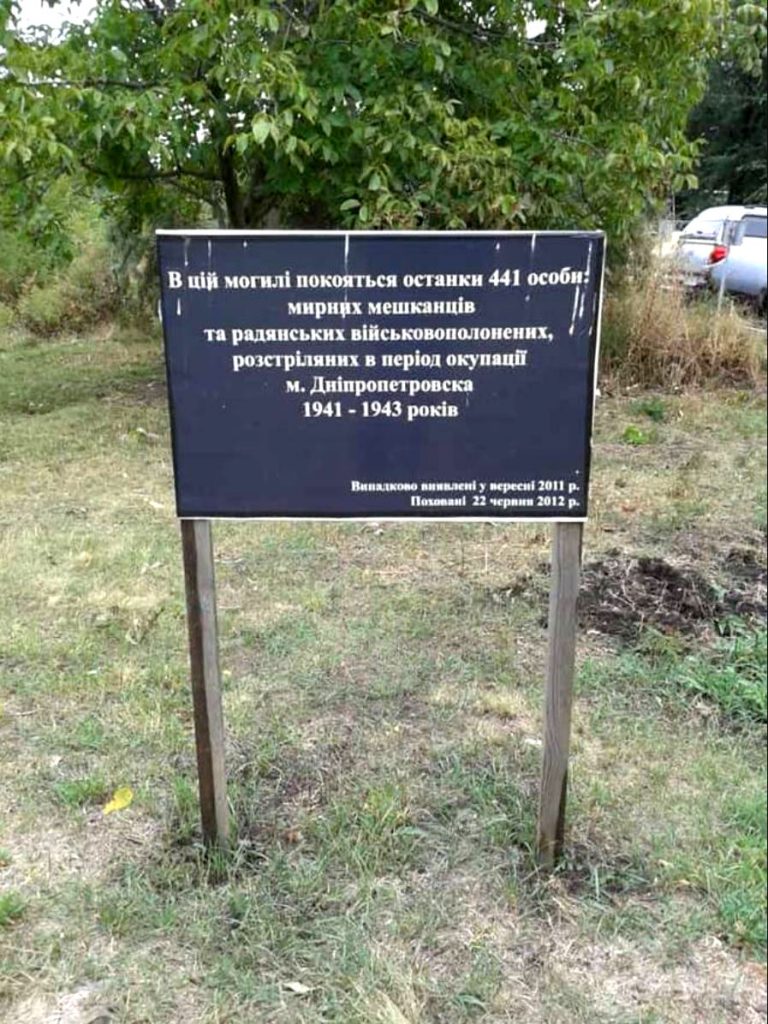
Some minor changes were also made to the last site connected with the Holocaust in the city of Dnipro, the intersection of Yangel and Enerhetychna streets. In 2011, during the reconstruction of the stadium that was built near the killing site, the remains of 441 bodies were found at a depth of nearly half a meter. This was further proof of the fact that during the Soviet period no exhumations had taken place and that the construction work had taken place literally on top of bones. In 2012, by order of the municipal authorities, the remains were buried next to the already erected memorial. Today, eight years later, a temporary memorial plaque is displayed at the new burial site. It bears the following (Ukrainian) inscription: “The remains of 441 people are buried in this grave: civilians and Soviet prisoners of war who were shot during the period of the occupation of the city of Dnipropetrovsk in 1941–1943.”
This is the only one of the three mass killing sites of Jews that does not make a single allusion to the victims’ identity. Compared to the inscription on the monument, a new category of victims is listed: “Soviet prisoners of war.” As for the word “civilians,” no clarification has ever been made. It is not clear whether this is a holdover from the Soviet past or a deliberate suppression. After all, the forensic team in charge of the exhumation divided the articles that were found during the disinterment between the Dmytro Yavornytskyi National Historical Museum and the Holocaust Museum [32] (which at the time was being readied for its opening), obviously keeping in mind the fact that some of the articles may have belonged to Jews who had been shot there.
Another aspect of the depiction of the Holocaust in the symbolic space of the city of Dnipro that merits attention is the issue of toponymy. In 2019, on the initiative of the associates of the Tkuma Ukrainian Institute for Holocaust Studies, a proposal was put forward to name two city streets in honor of the Righteous Among the Nations [33], people who helped save Jews during the Holocaust. Both of the streets are located in the central neighborhood, not far from the places where the remains of Jewish victims were reburied. Darwin Street was renamed in honor of Jan Chodorowski, a resident of Lviv who saved 26 Jews by supplying them with forged work documents for a German company. Yasna Street was renamed in honor of the Zubkov couple, residents of Dnipropetrovsk. Initially, they hid, then adopted, a Jewish girl, who was thus saved from being shot at the Botanical Garden on 13 October 1941. [34]
Conclusions
If we highlight the fundamental features that essentially influenced the representation of the Holocaust in the city of Dnipro, we must mention the powerful and persistent sentiment toward the Soviet Union, sufferance, and even the tendency toward eclecticism and the polyvariance [35] of the historical past, its inconsistency, and the resulting lack of a single, consensual narrative. The latter determines the diversity of the commemorative landscape, so to speak, the segregation of various memories. Even if they do not conflict from the outside, they still prefer to remain at a distance. At the same time, there is a consensus around the question of how this space should be divided among the Ukrainian, Soviet, and Jewish narratives. In the case of the Holocaust, this can be clearly seen in the example of the three sites: The first (Gagarin Park) is mostly a Jewish zone (because only Jews were killed there) and partly Soviet; the second (Pysarzhevsky Park) consists of three zones: the Jewish cemetery, the cross (the Holodomor), and the Soviet monument (mostly Jews were shot there, but there is no direct mention of this); and the third (the corner of Yangel and Enerhetychna streets) is exclusively a Soviet zone (identical phraseology both in the late Soviet text and the renewed post-Soviet one).
However, it bears noting that, against the background of such heterogeneity, in the last ten years a trend has appeared in Dnipro indicating a search for commonality and a more effective way to embed the Holocaust legacy in the urban space. Some striking examples of this direction are the use, in street names, of the names of the Righteous Among the Nations, whose stories are closely connected with the city, as well as a more insightful and unifying narrative on commemorative markers (for example, the text of the commemorative plaque on the TsUM [department store — Ed.] building). Without a doubt, the main initiator of the entrée and preservation of the memory of the Holocaust in the symbolic space of Dnipro is the Jewish community. The means of realizing this process is changing gradually. The more developed and influential Jewish community institutions become in the city, the closer it collaborates and communicates with various municipal milieus, and the more this community takes on a characteristically urban identity (its members’ awareness of themselves as not simply Jews but Dnipro Jews) the closer the Jewish heritage approaches the city.
This article was first published in 2020 in the journal Misto: Istoriia, kul′tura, suspil′stvo. Special issue: Holokost і misto: Prostory vbyvstva — prostory ruinatsiї (The Holocaust and the City: Spaces of Murder — Spaces of Destruction)
The article features photographs from the private archive of Anna Medvedovska as well as open sources.
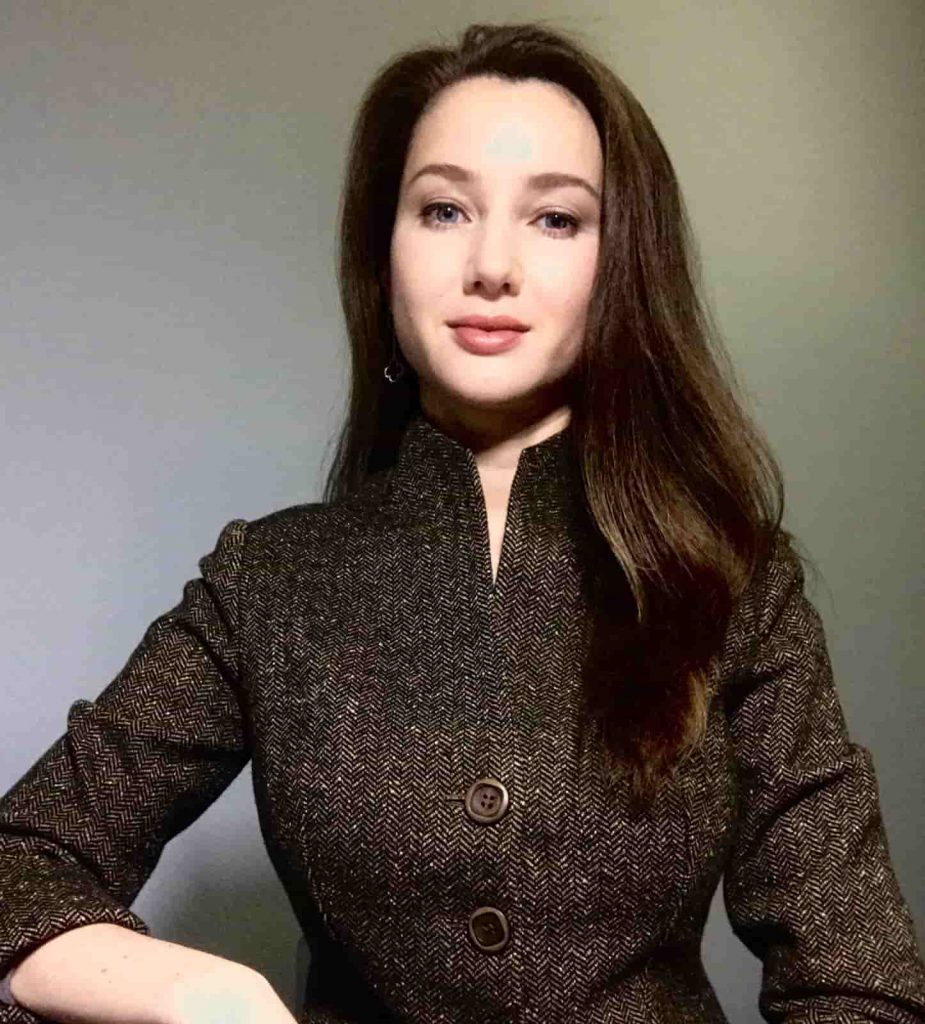 Anna Medvedovska is a Candidate of Sciences in History, Senior Scholarly Associate of the Tkuma Ukrainian Institute for Holocaust Studies (Dnipro), and managing editor of the journal Problemy istoriї Holokostu: Ukraїns′kyi vymir. As part of the Tkuma team, she developed and created a permanent exhibition of the Museum “Jewish memory and Holocaust in Ukraine” (2011–2012). She interned at the Jack, Joseph and Morton Mandel Center for Advanced Holocaust Studies, USHMM (2015–2016). In 2017 she defended her Candidate of Sciences in History dissertation entitled “The Holocaust in Ukraine in the Public Thoughts of the end of Twentieth–the beginning of Twenty-First Centuries.” She is the author of a number of articles on the reception of the Holocaust in Ukraine during the Soviet and post-Soviet periods, including “The Memorialization of the Holocaust in Ukraine in the Second Half of the Twentieth Century: The Reception of the Holocaust in Social Thought of the Late Soviet Era” (Problemy istoriї Holokostu, no. 8, 2016).
Anna Medvedovska is a Candidate of Sciences in History, Senior Scholarly Associate of the Tkuma Ukrainian Institute for Holocaust Studies (Dnipro), and managing editor of the journal Problemy istoriї Holokostu: Ukraїns′kyi vymir. As part of the Tkuma team, she developed and created a permanent exhibition of the Museum “Jewish memory and Holocaust in Ukraine” (2011–2012). She interned at the Jack, Joseph and Morton Mandel Center for Advanced Holocaust Studies, USHMM (2015–2016). In 2017 she defended her Candidate of Sciences in History dissertation entitled “The Holocaust in Ukraine in the Public Thoughts of the end of Twentieth–the beginning of Twenty-First Centuries.” She is the author of a number of articles on the reception of the Holocaust in Ukraine during the Soviet and post-Soviet periods, including “The Memorialization of the Holocaust in Ukraine in the Second Half of the Twentieth Century: The Reception of the Holocaust in Social Thought of the Late Soviet Era” (Problemy istoriї Holokostu, no. 8, 2016).
[2] A. Portnov and T. Portnova, “Stolitsa zastoia? Brezhnevskii mif Dnepropetrovska: Neprikosnovennyi zapas,” 5. Retrieved from.
[3] Ibid.
[4] The official name of the museum is Memory of The Jewish People and The Holocaust in Ukraine.
[5] A. Kruglov, “K voprosu o kolichestve evreev, unichtozhennykh einzatsgruppami v 1941–1943 gg., Holokost і suchasnist′ 1, no. 3 (2008): 39–64.
[6] K. Berkhof [Karel Berkhoff], Zhnyva rozpachu: Zhyttia і smert′ v Ukraїni pid natsysts′koiu vladoiu (Kyiv: Krytyka, 2011).
[7] A. Kruglov, A. Umanskii, and A. Shchupak, Kholokost v Ukraine: Reikhskomissariat “Ukraina”; Gubernatorstvo “Transnistriia” (Dnipro: Ukr[ainskii] in[sti]-[tu]t izucheniia Kholokosta, Lira LTD, 2016).
[8] Ie. Vradii, V. Rybalka, M. Stril′chuk, and D. Shatalov, Holokost u Dnipropetrovs′ku (Dnipro: Ukraїns′kyi instytut vyvchennia Holokostu “Tkuma,” LIRA, 2017).
[9] G. Kas′ianov, Past Continuous: Istorychna polityka 1980-kh–2000-kh: Ukraїna ta susidy (Kyiv: Laurus, Antropos-Logos-Fil′m, 2018).
[10] O. Haidai et al., Polityka і pam’iat′: Dnipro, Zaporizhzhia, Odesa, Kharkiv; Vid 1990-kh do s′ohodni (Lviv: FOP Shumylovych, 2018).
[11] Ibid., pp. 129–30.
[12] A. Portnov, “O trekh pamiatnikakh zhertvam Kholokosta: Razmyshleniia k 9 maia.” Retrieved from.
[13] Vradii et al., Holokost u Dnipropetrovs′ku, p. 131.
[14] Ibid., p. 134.
[15] Today: vul. Iana Khodorovs′koho (Jan Chodorowski Street).
[16] Vradii et al., Holokost u Dnipropetrovs′ku, p. 135.
[17] Kruglov et al, Kholokost v Ukraine, p. 156.
[18] Ibid.
[19] Vradii et al., Holokost u Dnipropetrovs′ku, p. 155.
[20] Ibid., pp. 156–57.
[21] Ibid., p. 160.
[22] City residents living near the mass killing sites (especially Pysarzhevsky Park) often mentioned that until the 2000s human bones were discovered by children or unearthed by dogs.
[23] Portnov, “O trekh pamiatnikakh.”
[24] Oleksandr Abramovych Fridkis, administrative head of the Dnipropetrovsk religious community, interviewed by Anna Medvedovska, 2015. Audio file held in the author’s personal archive.
[25] Vradii et al., Holokost u Dnipropetrovs′ku, p. 160.
[26] P. Nora, “Vsemirnoe torzhestvo pamiati,” Zhurnal′nyi zal, 2 (2005). Retrieved from.
[27] Ibid.
[28] Ibid.
[29] Portnov, “O trekh pamiatnikakh.”
[30] M. Bernhard and J. Kubik, introduction to Twenty Years after Communism: The Politics of Memory and Commemoration (Oxford: Oxford University Press, 2014), pp. 12–14.
[31] A. Miller, “Rost znachimosti institutsional′nogo faktora v politike pamiati — prichiny i posledstviia,” Politeia, 3 (2019): 90.
[32] Putevoditel′ po Dnepropetrovshchine — informatsiia o Dnepropetrovskoi oblasti. Mesto rasstrela nemetskimi okkupantami mirnykh grazhdan v Dnepropetrovske po ulitse Iangelia. Retrieved from.
[33] “V tsentre Dnepra dve ulitsy nazovut v chest′ mestnykh zhitelei, kotorye spasali evreev ot natsistov.” Retrieved from.
[34] M. V. Sukhanov, “V Dnepre nazvali ulitsy v chest′ Pravednikov narodov mira,” Khadashot, April 2019.
[35] Portnov’s lecture makes the point that Dnipropetrovsk is a city of multiple histories that to this day have not been compiled into a single narrative. Nearly every marker that exists in the city’s past has at least two versions and two interpretations. See “Konspekt letsiї А. Portnova: Dnipropetrovs′k — Iak opovisty istoriiu mista bez istoriї.” Retrieved from.
The accuracy of the facts and quotations cited in this article are the sole responsibility of the authors of the texts.
This project was made possible by the support of the Canadian charitable non-profit organization Ukrainian Jewish Encounter (UJE).
Originally appeared in Ukrainian @Ukraina Moderna
Translated from the Ukrainian by Marta D. Olynyk.
Edited by Peter Bejger.
NOTE: UJE does not necessarily endorse opinions expressed in articles and other materials published on its website and social media pages. Such materials are posted to promote discussion related to Ukrainian-Jewish interactions and relations. The website and social media pages will be places of information that reflect varied viewpoints.



















